History of Arcerion: Difference between revisions
| Line 1: | Line 1: | ||
[[File:Chester-on-Moore.jpg|thumb|Early artist rendition of Chester-on-Moore, c.1797 .]] | [[File:Chester-on-Moore.jpg|thumb|Early artist rendition of Chester-on-Moore, c.1797 .]] | ||
[[File:Governorates with Dates.png|thumb|Governorates of Arcerion with flags and the date they were Confederated into Arcerion as per Royal Decree. ]] | |||
The history of Arcerion began in the late eighteenth century with the settlement and establishment of Carnish colonies in the Southeastern Cronan Peninsula. The core territories of Arcerion's current sovereign borders would gradually expand until they reached their current state in 1975. Arcerion was predominantly settled | The history of Arcerion began in the late eighteenth century with the settlement and establishment of Carnish colonies in the Southeastern Cronan Peninsula. The core territories of Arcerion's current sovereign borders would gradually expand until they reached their current state in 1975. Arcerion was predominantly settled | ||
== Prehistory == | == Prehistory == | ||
| Line 51: | Line 52: | ||
Royal Arcerion Constabulary needs to play a major role in this one | Royal Arcerion Constabulary needs to play a major role in this one | ||
== Late Colonial History (1880s-1920s) == | == Late Colonial History (1880s-1920s) == | ||
=== Self-governance and growth === | === Self-governance and growth === | ||
| Line 64: | Line 64: | ||
== Late 20th Century == | == Late 20th Century == | ||
=== Fourth Bush War === | === Fourth Bush War === | ||
=== Polar Explorations and Howland Governorate === | |||
=== Emerging Role in Crona === | === Emerging Role in Crona === | ||
=== The Industry of Agriculture === | === The Industry of Agriculture === | ||
Revision as of 13:26, 3 September 2022
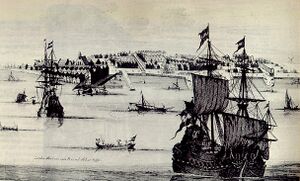
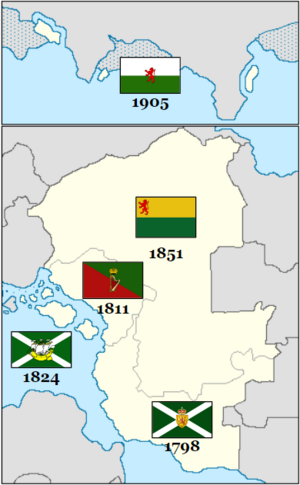
The history of Arcerion began in the late eighteenth century with the settlement and establishment of Carnish colonies in the Southeastern Cronan Peninsula. The core territories of Arcerion's current sovereign borders would gradually expand until they reached their current state in 1975. Arcerion was predominantly settled
Prehistory
Indigenous Tribes
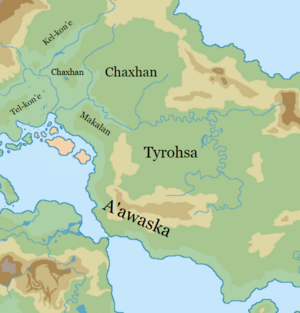
The indigenous tribes of Arcerion had been native to Crona for centuries prior to Occidental colonization. They were organized around small, multi-family bands that lived nomadic or semi-nomadic lifestyles, with limited access to Occidental-style agriculture or livestock. Culture and heritage were usually passed down orally, although some tribes such as the Makalan had limited written language texts as found in their abandoned camps. The tribes also were in a constant state of conflict, fighting each other over border issues or existing historical rivalry and feuds. In the Arcer Lowlands to the South, the A'awaska were the most dominant, living in small longhouses and with some earthen shelters in more permanent settlements. This represented a key difference between them and the Northern Tribes, who were more nomadic. In general, Arcer and Cronan historians have separated the tribes into two main geographic groups, the Northern and Southern Tribes, and within that they are separated into Highland and Lowland cultural tradition.
Northern Tribes
The dominant Northern Tribe was Chaxhan, which was considered culturally Lowland. They occupied the river basins and Arcer Heartland, and were the main opposition to Heartland settlements as settlers moved up the Innis and Leigh Rivers. They were also the main belligerent fighting against Arcerion during the Second Bush War, and participated to a limited extent supporting the Kel-kon'e in the Third Bush War. The Chaxhan were largely nomadic, with few to no permanent settlements in the Heartland, instead roving bands numbering between 50-500 indigenous people would move from location to location in accordance with season changes or based on decisions made by Tribal Chiefs and Tribal Elders. The Kel-kon'e and Tel-kon'e are two Northern Tribes that predominantly occupied the Northwestern Lowlands, in what would eventually become Oakham Governorate. They were semi-nomadic, with some settlements close to rivers and the Malentine Sea. The Tel-kon'e also had a limited ability to traverse open water and the littoral areas to the Malentine Islands, and occupied some of the Northern parts of Foxhey Governorate until they were forced to leave during the Third Bush War.
Southern Tribes
Southern Tribes are generally characterized by their semi-nomadic lifestyle, with a tendency to have several small-medium sized settlements of which the nomadic bands travelled through. The dominant force in this area was the A'awaska, who were the first tribe to come into contact with Carnish settlers. The A'waska consistently fought over a period of centuries the Tyrohsa, the main inland Southern Tribe, and to a lesser extent the Makalan. Both the A'awaska and the Makalan had written languages and some written texts, and possessed some forms of agriculture and a blended diet of both hunted and gathered sustenance as well as farm-grown vegetables. The Tyrohsa were entirely nomadic, relying on fishing in the McCallan River, and hunting the roving bands of deer and elk in the Arcer Heartland for sustenance. By the mid-1800s, the Tyrohsa had largely been driven out of the Southern portion of the Arcer Heartland, although during the Second Bush War, they were a main combatant in the Southeast.
Early Colonial History (1790s-1880s)
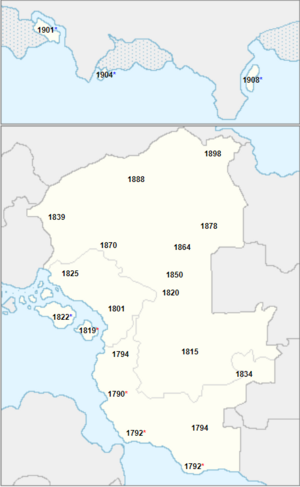
Carnish, Ænglis, and Gaelic Colonization
The Carnish Crown made a decision in the late 1770s that it had to expand its colonial empire, and looked to the continent of Crona as a possible new venture. To this point, it was relatively untouched by most other Occidental nations, with only Kirav having begun to establish some colonies in Paulastra and The Cape. Finally, a decision was made in 1787 to begin forming an expedition. Prominent AEngle socialite and former infantry officer, John Farley Hughes was appointed as Chief of the Cronan Expedition for the Kingdom of Carna, and given an allotment of £10,000 to fund and prepare an expedition. Carna's naval service provided two frigates, the Chester and the Windswept, and Hughes chose four larger two-masted Brigantines (Nathaniel, Sharp, Rednose, Bounty) to carry the necessary supplies for a convoy. The six ships set sail in July of 1789, making a stop in Cartadania for supplies, before continuing the journey to Crona. The first sighting of the Cape of Crona was in of November of 1789, with the ships passing into the Songun Sea the same month. Up to this point, the relatively fair summer weather on the Odoneru Ocean had been fair to the expedition, and there had been minimal damage to both the ships and their crew. They initially anchored at one of Kirav's Paulastran ports, before carrying through a narrow strait in the Northern part of the Songun - the first Occidentals to enter the Sea.
The Carnish AEngles and Gaels aboard Hughes' flotilla found a small bay, on the Eastern Coast of the Malentine Sea, choosing it as the initial landing site for their colony due to its calm waters, and low rolling hills surrounding the colony. Hughes brought the ships close to shore, and on January 3rd, 1790 the first Occidental boots made landfall in what would become Arcerion. Foraging parties went forward and by late February small buildings, a jetty for small craft, and a small artillery revettment had been set up in the town. Initially, they named it for Hughes to honour his achievement, and Kurst was formerly known as "Hughton," or Hughes' Town. However, in April of 1790 a considerable portion of the settlement was burned down in a fire. Although the settlers rebuilt, they soon encountered their first Indigenous peoples. Members of the A'awaska Tribe had previously been sighted fleetingly by members of the expedition when foraging or hunting inland, but no sustained contact was made. Then, in March of 1790, a sailor shot and killed an Indigenous man he found digging through his garden, killing him instantly. Not knowing what to do with the body, the Carnish settlers left the body on a small pile of rocks on the city outskirts, believing the locals would prefer to recover and bury their dead according to their own rituals. The Hughes' Expedition only religious representative, the Anglican, Deacon John Turnbull, even said last rites as per Carnish tradition in case the A'awaska had no intention of reclamation. However the local Indigenous saw this as disrespect as they buried their dead much like Carnish peoples, and took this to mean the people of Hughes' Town were disrespecting their dead. As such, not two weeks after the fire, they raided the small settlement, killing a dozen and wounding an equal amount of the settlers, who fled back to the jetty and the artillery revettment. Cannon fire and a concentrated effort from sailors, the ship's company of marines, and the local militia pushed back the Indigenous, who left a twenty or so dead or dying across the town before fleeing into the hills. This caused John Hughes to claim, "This damn land is cursed, first a fire? Then this? What a damned place Crona is." Over time, this name stuck to what would eventually become Arcerion's capital, and 'cursed' gradually transformed into 'Kurst,' the Gaelicized-version of the word.
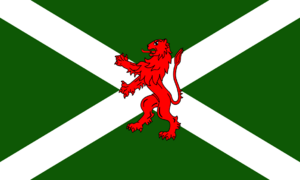
By the end of 1790, John Hughes left Frederick Marlborough as the commander and governor of the small Carnish colony. They had erected a small palisade and earth berms, and expanded the artillery revettment using spare four and six pound cannons from the frigates. Hughes set sail in the Windswept, with the Rednose following closely, bound for Carna to inform the King of the successful establishment of a Crown colony. Hughes informed the King of the success, and the Crown Royalty of Carna was overjoyed. They demanded an immediate follow-up expedition, with a dozen more ships packed with excited colonists to explore the new land. Most of these settlers were Ænglish and Gaelic, and this immigration trend would continue, giving Arcerion a dual cultural heritage. Hughes also travelled with a Royal Decree backdated for January 3rd, 1790 declaring the creation of the Carnish Colony of Crona, and naming him Crown-Governor. Although he is the first Crown-Governor of Arcerion, in the recognized history by the Confederate Parliament, Frederick Marlborough is the first head-of-government in Arcerion. Hughes would leave in late 1971 with a second flotilla of a fourteen ships, including Windswept, and would return to the colony, first landing several ships at what he was bemused to learn was now no longer Hughes' Town, but 'Kurst.' He then took six ships, and landed three apiece along the Songun Shore of the colony to the South, one of these ships, Chester, becoming fouled in rocks not far from a large stretch of moorland, which ironically became the settling place for the future bustling port city of Chester-on-Moore. The smaller port city to the South of this was also established, Port Hughes was settled, which Hughes joked finally gave his name some meaning on the continent.
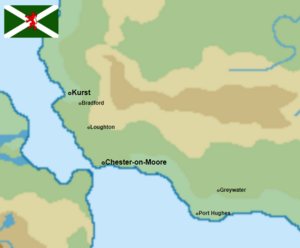
By the eve of 1793, two major settlements, Kurst and Chester-on-Moore had been established, and multiple smaller homesteads and farms had begun to appear, with the new settlers taking to irrigating, tilling, and farming the land, and raising and breeding the livestock that had survived the journey from Carna. Unexpectedly, in the spring of 1793, more sails were spotted on the horizon from Port Hughes' small coastal battery, and they hailed them using signal flags. The ships were additional expeditionary and settlers sent by the Carnish Crown, including 12 pounder guns, horses, gold pieces, and other necessary resources to establish a more permanent presence. The ships were divided, with a pair staying anchored off the coast of Port Hughes, and the remainder carrying on up the coast to Kurst. In Kurst, the Crown-Governer's mansion had begun the process of being constructed, as had Fort Ellis, named for one of the men killed in the initial A'awaska raid of 1790. With the arrival of additional ships, the growing colony now numbered well over a thousand, with Chester-on-Moore rivaling this. Construction on a larger jetty and berthing for ships was begun, and other key infrastructure such as windmills had undergone improvements since the initial once were built in 1790. Individual ships by themselves or in small groupings would arrive and deliver supplies and new settlers, and the small colony swelled. Kurst now had distinct districts and a bustling main road, including a pair of popular pubs, both served by the same brewery. Initial issues of governance meant that John Hughes had to spend less time on inland expeditions and hunting trips, and more time in the Crown-Governor's residence, dealing with daily issues of governance. In 1793 he also directed the establishment of the Arcerion Loyal Militia, to augment the company of marines from the Carnish naval service. Hughes also began the process of organizing survey parties to go inland and map, chart, and catalogue the land. Plans were made to connect Kurst to Chester-on-Moore via road, and expand the amount of settlers immigrating to inland towns such as Bradford and Loughton. Plans were also made to attempt to explore North along the coast. While Hughes as Crown-Governor has authorized the Windswept and Nathaniel to conduct limited expeditions Northwards, he was leery of spreading their resources too thin while the colony was so small and vulnerable. It was also during this time that the Carnish Colony of Crona was named Arcerion for first time. Sightings of a sea monster off the coast of Chester-on-Moore prompted the locals to call the land "Ar-Ceirean," which was reported to Crown-Governer Hughes, who believed that to be a fitting name for the foggy moorland they now set out to colonize.
First Bush War
See: Arcer Bush Wars
Write this blurb after the First Bush War, keep it short, 2-3 paragraphs.
Second Bush War
Can't write further than these until this is complete (1839-1850)
1815 some skirmishes with Tyrohsa peoples but they go North seeing as the A'waskans got massacred in the First War
Framework: Norham established functionally, Moorden is fully running
Easthampton established 1834 as a mining town
No major pushes up the river yet, mostly coastal and some Arcer Heartland expansion
Foxhey governorate also established via colonization after the first bush war (1 carnish expedition, 1 arcer)
War is started by trying to push up river
Fought against Chaxhan and Tyrohsa tribes
war is pretty inconclusive initially, minor territorial gains in the Innis River Basin, but the Tyhrohsa are pushed out of the southern heartlands compeltely, but the maine effort was to push upriver
1849-50 are major years, allow for smashing of large warbands and establishment of forts up the river
introduction of riverboats to transport troops up and downriver is a gamechange, as is armoured river gunboats (riverine monitors essentially)
sets condition for Chaxhan being pushed Northwards a ways to the edges and periphery of the rivers
Royal Arcerion Constabulary needs to play a major role in this one
Late Colonial History (1880s-1920s)
Self-governance and growth
Industrialization and railways
Third Bush War
First Great War
The Arcer Heartland
Early 20th Century
Second Great War
Carnish Civil War
Last Bastion of Royal Carna
Late 20th Century
Fourth Bush War
Polar Explorations and Howland Governorate
Emerging Role in Crona
The Industry of Agriculture
The Arcosphere
Modern History
CSTU
Foreign Policy and South Cronan Leadership
Economic Growth and Polynesian Initiatives
All Old/Partially Canonical
Arcerion was first settled by early Carnish populations in the 1790s, becoming a recognized and organized colony in the Kingdom of Carna in 1793. In the period that followed, Kurst, Kinnaird, and Chester-on-Moore all grew into prosperous colonial towns, providing jobs and stability in a region that was noted for its shifting political states and reliability of colonial partners. Arco settlers spread quickly to what would become the rolling plains of Northlea governate, taking their pluck and knack for farming and creating vast farming estates, helping to boost the early colony's independence on foreign foodstuffs and goods by increasing tis self-reliance. By the 1830s, expansion into the mountains had begun, and the small mining town of Easthampton had discovered the resources that would help solidify Moorden's future as a raw ore and industrial processing center in Crona. Gained economic and interior governance independence in the 1880s. Full independence just before the Great War. A series of border skirmishes with their indigenous neighbours to the North would be a constant, with Arco militia forces taking over the bulk of the country's policing and security operations by the 1860s. Carnish influence continued to exist in the capital, and Arco settlers still proudly identified their loyalty to the crown and identified as citizens of Carna until they were granted self-rule and governance in 1886. By this time, there was only token presence of Carnish tax inspectors, administrators, and politicians, with the vast majority of government positions having been taken over by Arcer citizens. It was roughly this time that Carna began to permit the issuance of passport-equivalent paperwork and allowed Arcerion to have its own self-determined foreign policy, beginning with the fledgling emergence of Arcerion's Foreign Office, which first began as the Foreign Secretary and their staff.
Self governance brought its own series of challenges as Arcerion grappled with instituting its own public services and administrations. Arcerion specifically focused on the overhaul of its Parliament, resulting in the legislature moving away from a colonial model to a two-tiered system with an upper and lower house. By moving the lower-house to the Provincial/Governate level, the hope was that the creep of federal power would not detract from the Confederation as a whole. The result was a decentralized approach to governance allowed for individual governates to grow, with the assurance that the collective would support in times of need. By the late 1890s, increased border skirmishes required the country's first 'sovereign' or 'independent' deployment of military forces to Northlea and what was then-Northlea's Western portions, and what would eventually become Oakham governate. Multiple Arcer infantry, cavalry, and the first light artillery formations were sent North to combat the growing restlessness of indigenous populations who had begun to attack and murder families of Arcer farmers as they ventured out into the Cronan wilds to stake their claim. This period, The Border Wars, would help form part of modern (2000s) Arco policy towards Kelekona and Titechaxha, wherein the borders are rigorously patrolled and monitored.
The addition of Carna granting limited independence for economics and foreign politics meant Arcerion was finally able to unilaterally negotiate in Southern Crona, establishing relationships early with the two Kiravian colonies there, the Cape and Paulastra. Relations were generally friendly with both, as the hardships of settling Southern Crona was generally a bonding tenet of foreign policy on the continent. As the decades continued the economy continued to grow, with Moorden's raw iron ore exports shipped through the Songun Straits out to the old world, and Arcer foodstuffs from Northlea governate slowly becoming more prevalent in markets and groceries through Southern Crona. Roads and rail systems began to be created under new infrastructure projects, as early politicians used the limited federal taxes and income to benefit the average Arco citizen. The establishment of the Arco National Railway Service (ANRS) in 1886 resulted in the nation's first heavy commercial rail line from the Kinnaird-Kurst areas to Easthampton to carry raw resources to ports for transport to manufacturing facilities abroad.